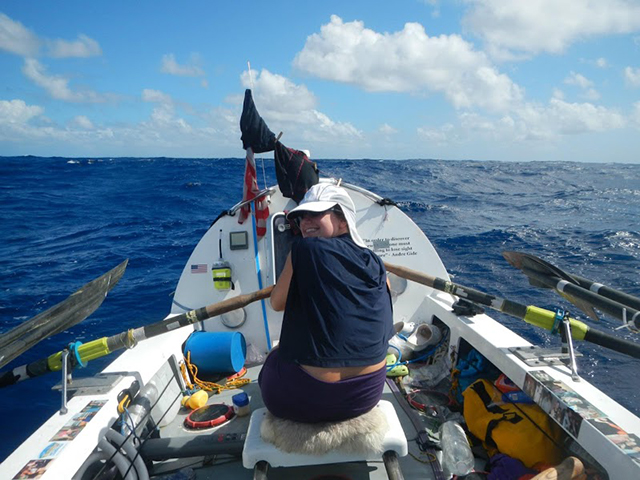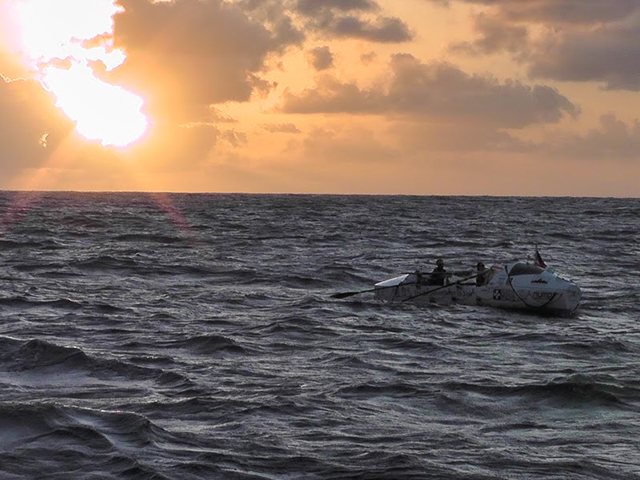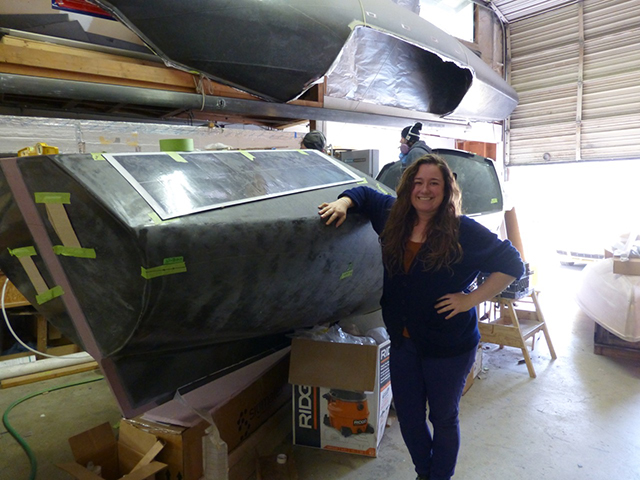
Part of the Series
Planet or Profit
Sonya Baumstein has rowed across the Atlantic Ocean, kayaked from Seattle to Juneau, and paddled across the Bering Strait.
But now she is in final preparations to become, at 29 years old, the first woman to row across the Pacific Ocean. From Choshi, Japan, to San Francisco, her route will carry her over 5,700 nautical miles of what is arguably the most challenging open ocean crossing in the world, one that will include winds in excess of 50 knots, over 40-foot-high seas, and the threat of freighters and other large vessels.
To see more stories like this, visit “Planet or Profit?”
She will take on the 150-plus day voyage solo, in her 23-foot rowboat, supported only by a small land-based group of advisers via satellite phone.
“This is all aimed towards shining the light on climate change.”
Truthout caught up with Baumstein in Port Townsend, Washington, where she was finishing construction on her boat and making final arrangements. In April, she will fly to Japan to begin her trans-Pacific row.
“This is all aimed towards shining the light on climate change,” Baumstein said. “Humans are doing so much to exacerbate it, and we don’t even know all of the ramifications of our actions.”
The oceans cover 71 percent of the planet and contain 97 percent of all the water on earth. They are where the planet’s weather systems are formed, and they are absorbing astronomical amounts of carbon dioxide and human-generated plastic and garbage.
Baumstein hopes her journey will bring people’s attention to these crucial impacts of climate change and environmental degradation.
“The oceans are full of data,” Baumstein said. “They have all this data that we could use to unlock some of the keys to climate change.”
And she’s willing to put her life on the line to do so.
Oceans of Pollution
While on her voyage rowing across the Atlantic with three colleagues, Baumstein was shocked by what she saw.
“When we hit the Sargasso Sea, inside of these massive seaweed floats, is trash,” she said. “We are 500 miles out from shore, and we are seeing miles of garbage, this biosphere full of rubber boots and toilet seats, and I thought there must be something I can do to tell people about this, to show them what the effect of this is on their daily lives.”
 (Photo: Expedition Pacific)
(Photo: Expedition Pacific)
Baumstein paddled through these floating trash piles for two days, stunned by what she saw, which was unfortunately just the tip of an iceberg of which we haven’t yet found the end.
The amount of plastic pollution in the oceans has risen alarmingly over the last 40 years, and continues to escalate.
However, if what Baumstein saw in the Atlantic shook her, she must brace herself for what she’s going to see in the Pacific.
The amount of plastic floating in the Pacific Gyre – a massive swirling vortex of rubbish – has increased 100-fold in the past four decades.
One warning of humanity’s increasingly deleterious impact on the oceans came from prominent marine biologist Jeremy Jackson of the Scripps Institution of Oceanography. In a 2008 article published in Proceedings of the National Academy of Sciences, Jackson warned that, without profound and prompt changes in human behavior, we will cause a “mass extinction in the oceans with unknown ecological and evolutionary consequences.”
We are inextricably tied to the oceans in ways we often don’t consider. As science journalist Alanna Mitchell has written: “Every tear you cry … ends up back in the ocean system. Every third molecule of carbon dioxide you exhale is absorbed into the ocean. Every second breath you take comes from the oxygen produced by plankton.”
Recent years have found scientists investigating the North Pacific Subtropical Gyre, known as the “Great Pacific Garbage Patch.”
“Probably every sea turtle on the planet interacts with plastic at some point in its life.”
The eastern section of the spiraling mass, between Hawaii and California, is estimated to be around twice the size of Texas (some estimates peg the entire mass at twice the size of the continental United States), and is having ecosystem-wide impacts, according to a recent study published in Biology Letters.
Miriam Goldstein, a graduate student researcher at Scripps Institution of Oceanography at the University of California, San Diego, and the lead author of the study, told Truthout that by adding this amount of plastic to the oceans, humans could be causing large-scale change to the ocean’s ecological system.
“We found eggs on the pieces of plastic, and these were sea skater [insect] eggs,” Goldstein said. “Sea skaters naturally occur in the gyre and are known to lay their eggs on floating objects. So we found that the amount of eggs being laid had increased with the amount of plastic.”
Goldstein says that, although the study’s findings clearly raise immediate concerns, the most serious consequences may be ones we can’t yet foresee. “Our work shows there could be potential effects to the ocean ecosystem that we can’t expect or predict,” she said. “There are five subtropical gyres, one in each ocean basin, and they are natural currents. They are vast areas of the oceans; together they comprise the majority of the area of the oceans. So altering them on a large scale could have unexpected results on all kinds of things.”
The study shows how an increase in pollution, in this case an immense amount of plastic, may have dire consequences for animals across the entire marine food web.
This Scripps study follows a report by colleagues at the institution that showed that 9 percent of the fish collected during the trip to study the gyre had plastic waste in their stomachs.
Published in Marine Ecology Progress Series, that study estimated that fish at intermediate ocean depths in the North Pacific Ocean could be ingesting plastic at the staggering rate of 12,000 to 24,000 tons per year.
“From a climate change/fisheries/pollution/habitat destruction point of view, our nightmare is here.”
Dr. Wallace J. Nichols, a research associate at the California Academy of Sciences, told Truthout he finds plastic on every beach he visits across the globe, and added, “Probably every sea turtle on the planet interacts with plastic at some point in its life.”
Jo Royle, a UK-based trans-ocean skipper and ocean advocate, has seen the same.
“For 13 years I’ve been crossing oceans,” she told Truthout. “I’ve seen plastic on the coastline of Antarctica, and over the years we’ve noticed plastic becoming more of an issue on remote islands. Over the last seven years we’ve seen it increase dramatically. I can’t remember the last time I’ve been on a beach and not seen plastic.”
Biological oceanographer Dr. Debora Iglesias-Rodriguez, with the National Oceanography Centre at Britain’s University of Southampton, is concerned that ocean pollution isn’t viewed as a pressing issue – despite the fact that it is accelerating.
“Marine pollution is a big issue,” she told Truthout. “There is this idea that oceans have unlimited inertia, but nanoparticles of plastic getting into marine animals and the food chain are affecting fish fertility rates, and this affects food security and coastal populations. Pollution is having a huge impact on the oceans, and is urgent and needs to be dealt with.”
Nichols concurs, adding that, when it comes to the oceans, we are now seeing the cautionary predictions of previous decades coming true.
“From a climate change/fisheries/pollution/habitat destruction point of view, our nightmare is here; it’s the world we live in,” Nichols said. “You see evidence of the impact of climate change on the oceans everywhere now. The collapsing fisheries, the changes in the Arctic and the hardship communities that live there are having to face, the frequency and intensity of storms – everything we imagined 30 to 40 years ago when the environmental movement was born, we’re dealing with those now…. The toxins in our bodies, food web, and in the marine mammals, it’s all there.”
How Many More Fish in the Sea?
Baumstein has also seen evidence of the dramatic decline in the world’s fisheries.
“Doing the Inside Passage I became much more aware of [the impacts of] climate change,” she explained. “The seiner fleet in Canada – for the salmon season, it’s gone from 350 boats down to 28. Without even bringing up climate change, it was the topic of conversation. They talked about how important sustainability is, and they get that this is not a resource that can be extended much further. They discussed how the fish are even changing in how they taste.”
Worldwide, 90 percent of large predatory fish stocks are now gone due to overfishing, not including the impacts of climate disruption. Given that seafood is the primary source of protein for more than 1 billion of the planet’s population, this is a worrisome statistic.
The UN Food and Agriculture Organization (FAO) estimates that 85 percent of fish stocks are “overexploited, depleted, or recovering from depletion.”
Dr. Maria Salta, a biological oceanographer at the University of Southampton, gave Truthout a bleak prognosis for the oceans and the species that inhabit them. “It is clear that if we continue like this, in a few years time there is not going to be much left,” she said, referring to the rampant overfishing going on across the globe, along with the overall treatment of oceans at the hands of humans. “We are losing species every day without ever knowing about them. Sometimes humans can be like a plague to the environment.”
Salta’s statement might be shocking to some, but there is ample scientific evidence to back it. Overfishing is simply a matter of taking wildlife from the sea at rates that are too high for the fished species to replace themselves. Atlantic cod and herring, along with California’s sardines, were overfished to the brink of extinction by the 1950s, and by the late 20th century, instances of isolated depletions (depletions occurring in specific areas) had become both global and catastrophic.
“Thirty percent of marine catch is thrown overboard dead.”
Fisheries for the most sought-after species have since collapsed. Boris Worm and Ransom Myers, both scientists with Dalhousie University in Halifax, Canada, published a shocking paper in the journal Nature in 2003, explaining that the populations of all large predator fish in the oceans have declined by 90 percent in the 50 years since modern industrial fishing became widespread.
Three years later the same scientists, along with colleagues from across the world, published an even more startling paper that predicted a total collapse of all fish that are currently caught commercially by 2048.
Daniel Pauly of the University of British Columbia, along with others, has calculated that the world’s total fish catch peaked in the mid-1980s and has been in decline every since.
Dr. Simon Boxall, also with the University of Southampton, has been an oceanographer for more than 30 years. He sees the three largest threats to the oceans as climate change, plastic and overfishing.
“But the big problem is that we are overfishing,” Boxall told Truthout.
A key example of this rapid depletion: sharks. The International Union for Conservation of Nature has listed about a third of all open-ocean shark species as currently threatened with extinction because of overfishing.
“The oceanic white-tip shark populations declined by 99 percent from 1950 to 1999, making it now an endangered species,” Salta said. “Also, when sharks are removed from the environment you change the balance of the ecosystem and how it functions.”
An issue that works in tandem with overfishing is bycatch, which is sea life that is caught along with the fish being sought commercially. Salta thinks bycatch could be one of the most worrying problems facing the oceans, and goes as far as saying that bycatch is “a mode of mass marine extinction.”
“If organisms drop out of the food chain, the entire ecosystem is impacted.”
“From 1994 onwards, 27 million tons of bycatch are discarded every year,” she said. “Thirty percent of marine catch is thrown overboard dead. For shrimpers, 80 percent of everything caught is bycatch and thrown back for dead.”
According to the Pew Environmental report “Protecting Life in the Sea,” nearly one-third of the world supply of commercially caught fish has already collapsed.
Salta explained how many of the problems besetting the oceans converge to create a cascading, devastating effect on sea life.
“If organisms drop out of the food chain, the entire ecosystem is impacted,” she said. “And temperature affects biodiversity and fish stock. Changes in this variable can impact the entire ecosystem and impact fish stocks.”
She cites copepods (tiny crustaceans) in the North Sea as an example. “There was a specific species that hatched in the spring, that was for cod, but during the 1990s because of temperature change, these were replaced with a warmer weather copepod and these hatched too late,” she said. “So the cod have vanished there, coupled with exploitation by man.”
Salta said that 25 percent of the planet’s biodiversity is in danger of extinction within the next 30 years due to commercial fishing.
“When fish become overfished, the human response is to fish down the species to smaller species, so this shifts the target group down, and this affects biodiversity and the ocean ecology,” she explained.
Another aspect of overfishing is trawling – a fishing method that involves pulling fishing net through the water behind a boat. Bottom trawling, when the net literally drags across the seafloor, has severely destructive impacts.
“It’s the equivalent of forest clear-cutting, but in the ocean, because when they [fishermen] trawl the entire bottom, whatever is there is removed from the environment and changes the entire ecosystem,” Salta said. “Biomass of the deep sea is in sharp decline because of trawling.”
Bleak Scenario
Beyond marine life, the ocean’s critically important role in climate disruption cannot be overstated.
Scientists estimate there are approximately 3,000 gigatons (one gigaton is 1 billion tons) of carbon in the atmosphere. The oceans hold around 38,000 gigatons of carbon, which is 16 times as much carbon as the terrestrial biosphere (all plant and underlying soils on the planet), and 60 times as much as the pre-industrial atmosphere held.
Since the ocean is the greatest of all the carbon reservoirs, it fundamentally determines the carbon dioxide content of the atmosphere. Additional atmospheric carbon produced by the burning of fossil fuels gets absorbed by an already overburdened ocean.
The Zoological Society of London reported in July 2009 that “360 [carbon dioxide atmospheric parts per million] is now known to be the level at which coral reefs cease to be viable in the long run.”
In September 2009, Nature magazine stated that atmospheric carbon dioxide levels above 350 parts per million “threaten the ecological life-support systems” of the planet and “challenge the viability of contemporary human societies.”
We are now at 400 parts per million. Even by 2009, we were already well over 350 parts per million.
Carbon emissions have already risen “far above even the bleak scenarios.”
In its October 2009 issue, the journal Science offered new evidence of what the earth was like 20 million years ago, which was the last time we had carbon levels this high. At that time, sea levels rose over 30 meters and temperatures were as much as 18 degrees Celsius higher than they are today.
According to the Intergovernmental Panel on Climate Change, carbon emissions have already risen “far above even the bleak scenarios.”
Oceans absorb 26 percent (2.3 billion metric tons) of the carbon human activities release into the atmosphere annually, according to a 2010 study published by Nature Geoscience and The Global Carbon Project.
Unfortunately, global carbon emissions are continuing to increase. At a 2008 academic conference, Exeter University scientist Kevin Anderson showed slides and graphs “representing the fumes that belch from chimneys, exhausts and jet engines, that should have bent in a rapid curve towards the ground, were heading for the ceiling instead.” He references the famous “hockey stick graph,” that has become so well-known with climate disruption trends now, where charts abruptly tend nearly straight up, rather than showing more linear, gradual increases.
Anderson concluded it was “improbable” that we would be able to stop carbon dioxide emissions from rising to 650 parts per million, even if rich countries adopted “draconian emissions reductions within a decade.”
That number, should it come to pass, would mean that global average temperatures would increase five times as much as previous models predicted.
The US National Oceanic and Atmospheric Administration (NOAA) released a study in 2009 showing that a new understanding of ocean physics proved that “changes in surface temperature, rainfall and sea level are largely irreversible for more than a thousand years after carbon dioxide emissions are completely stopped.”
Part of a Solution
Myriad other problems beset the oceans: increasing acidification, dead zones, fish migrating to different areas because of temperature changes, loss of phytoplankton and bleaching coral.
It seems overwhelming, yet the enormity of the problem is precisely what is driving Baumstein.
 (Photo: Expedition Pacific)
(Photo: Expedition Pacific)
“I’ve been preparing for an expedition like this for years now, and I have a great team supporting me,” she said. “And this journey gives me the ability to be an active citizen/scientist, a chance to connect the proverbial dots for people, via electronic resources, to show people we can all do this since this information is around us in our daily lives as well.”
Baumstein will be collecting data as she rows, as her carbon-fiber boat will be equipped with solar power, a satellite phone and numerous scientific data collection devices.
“I have the opportunity to provide scientists with something they’ve never had, from changing salinity, to changing water temperature, to a better understanding of El Niño and disappearing snow on land,” she said. “All these things are connected.”
Baumstein said her boat is “basically a human-powered wave glider” that will carry a device she called the CTD (conductivity, temperature, depth), which measures these metrics and sends the data via her boat’s GPS tower to a satellite.
“This will generate a data flow of the currents, wind, and how stirred up the water layers are,” she said. “The salinity is important because it drives current and temperature. And you have pools of freshwater they are trying to understand, and they’ve never been able to collect data in the first foot of water, consistently.”
The data Baumstein collects will be sent to the Seattle-based company Earth and Space Research, which is the principal scientific investigator for NASA’s Aquarius project, which is a space agency satellite that monitors the world’s oceans.
“So I’m providing the grounding data,” she said. “And all the NOAA data the public sees comes from the Aquarius satellite.”
All of the data is to be open source, so the public can view it online, as well as watch Baumstein’s progress across the Pacific.
She aims to shove off from Japan in May, and is bringing 150 days of primary food supplies and 30 days of “backup” rations.
 Sonya Baumstein with her boat in Port Townsend, Washington. (Photo: Dahr Jamail)
Sonya Baumstein with her boat in Port Townsend, Washington. (Photo: Dahr Jamail)
Baumstein understands she will not be doing a lot of sleeping along the way.
“Sleeping patterns are dependent on weather, so if I have good weather, I’m going to row more,” she explained. “I’ll wake up every hour when I sleep to look at water temperature, so I have to monitor the currents, which are changing constantly.”
She will begin in the Kuroshio current, which is one of the fastest and thinnest in the world, and shifts between 50 to 100 miles on any given day.
“I have to stay in that current because it’s the only way folks can get across the ocean,” she said. “So there’s a lot of seamanship that goes into this.”
Baumstein is banking on her knowledge, experience and drive to get her across the largest ocean on the planet. And with a little luck, her voyage will be successful, as will her endeavor to bring more public attention to the plight of the oceans she rows across.
“This is the only planet we have,” she said. “So why not learn more about it while trying to take care of it?”
Our most important fundraising appeal of the year
December is the most critical time of year for Truthout, because our nonprofit news is funded almost entirely by individual donations from readers like you. So before you navigate away, we ask that you take just a second to support Truthout with a tax-deductible donation.
This year is a little different. We are up against a far-reaching, wide-scale attack on press freedom coming from the Trump administration. 2025 was a year of frightening censorship, news industry corporate consolidation, and worsening financial conditions for progressive nonprofits across the board.
We can only resist Trump’s agenda by cultivating a strong base of support. The right-wing mediasphere is funded comfortably by billionaire owners and venture capitalist philanthropists. At Truthout, we have you.
We’ve set an ambitious target for our year-end campaign — a goal of $250,000 to keep up our fight against authoritarianism in 2026. Please take a meaningful action in this fight: make a one-time or monthly donation to Truthout before December 31. If you have the means, please dig deep.